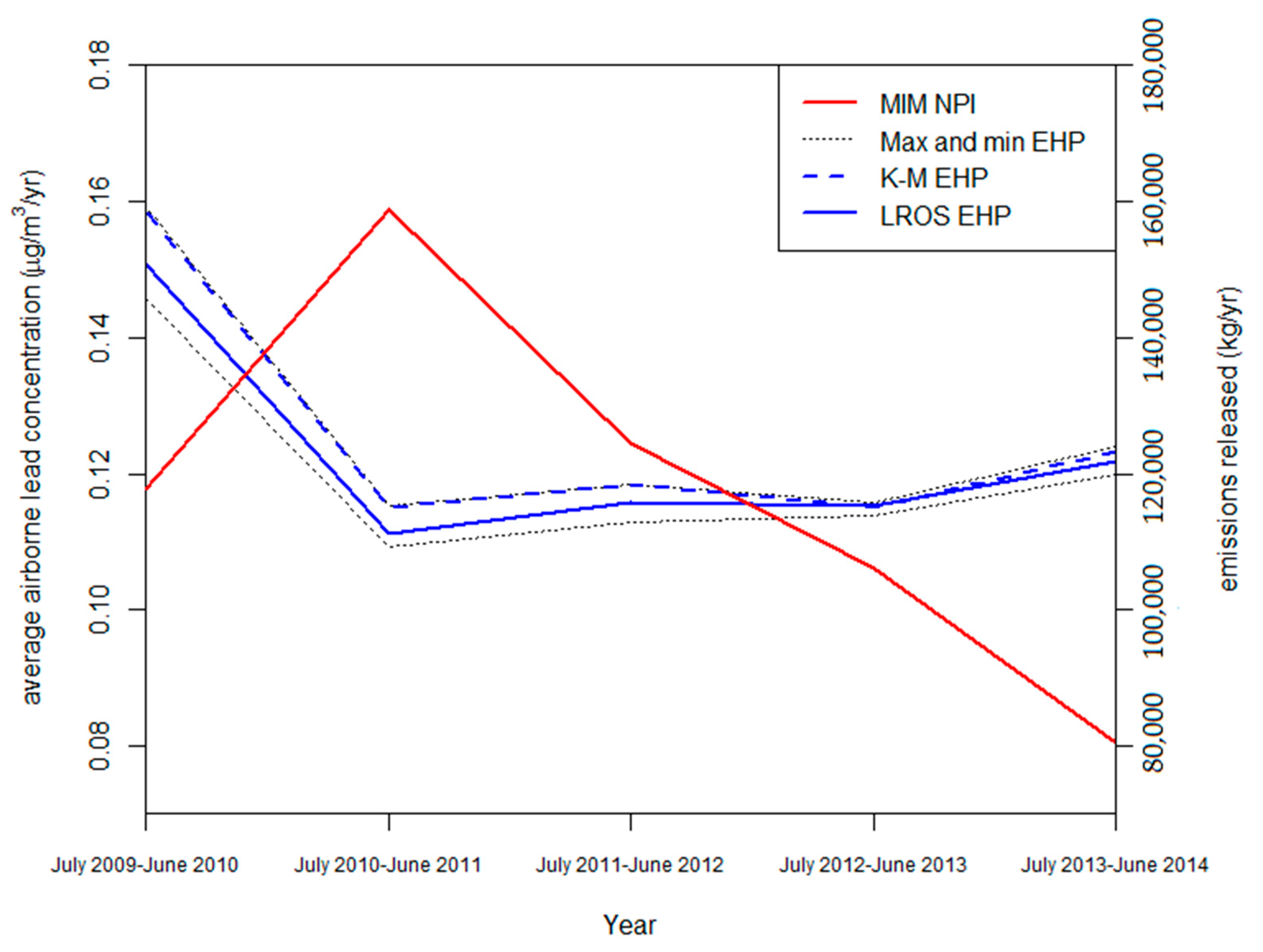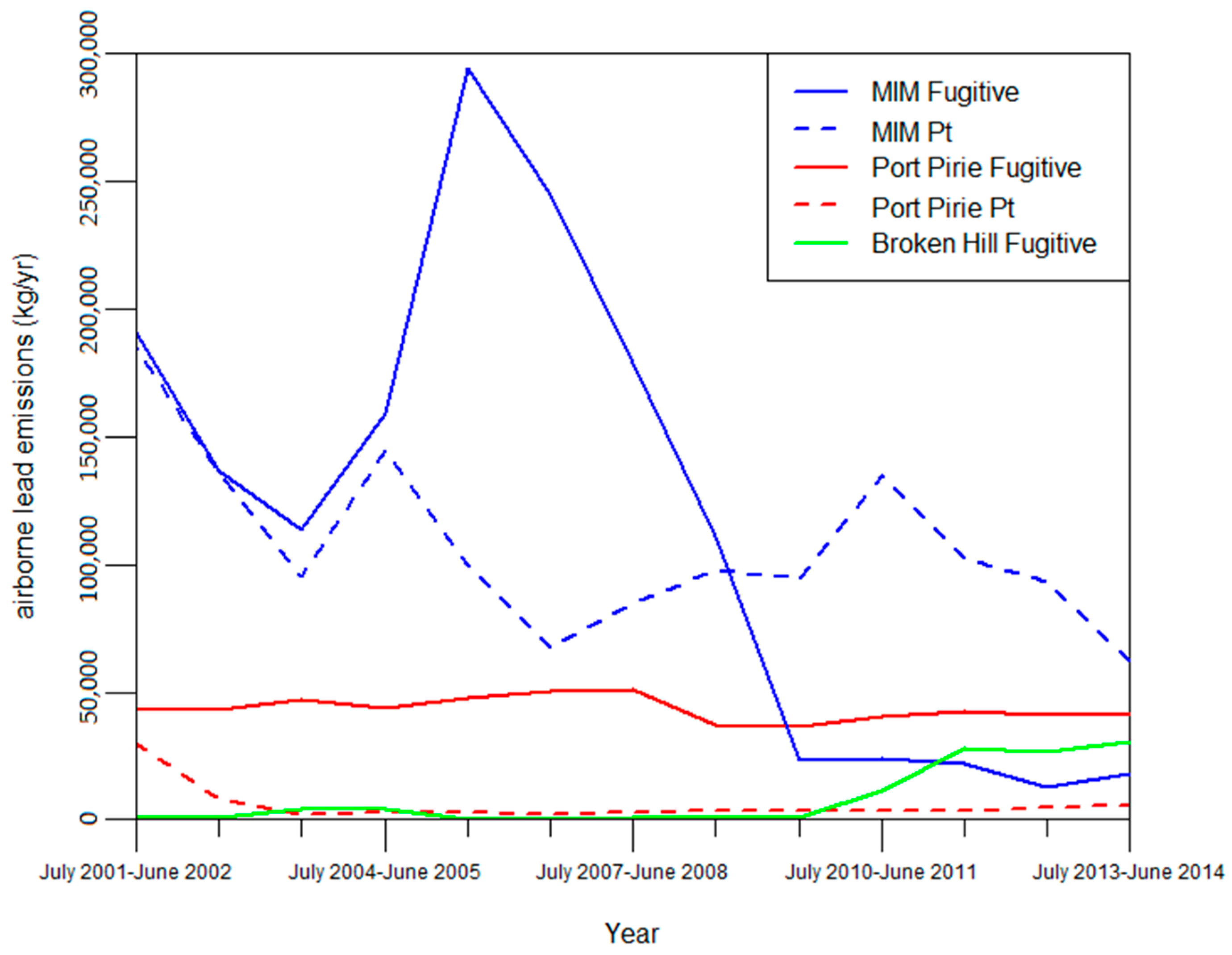The Australian National Pollutant Inventory Fails to Fulfil Its Legislated Goals
Abstract
:1. Introduction
“(a) collect a broad base of information on emissions and transfers of substances on the reporting list, and (b) disseminate the information collected to all sectors of the community in a useful, accessible and understandable form”.[1] (p. 12)
2. Methods
2.1. Facility Source Emissions
2.1.1. Assessment of the Accuracy of NPI Facility Emissions Estimations
2.1.2. Assessment of the Consistency of NPI Facility Emissions Estimations
2.2. Diffuse Source Emissions
2.2.1. Assessment of Accuracy for Diffuse Source Emissions
2.2.2. Assessment of Consistency for Diffuse Source Emissions
3. Results
3.1. Facility Source Emissions
3.1.1. Accuracy of NPI Emissions Estimations
3.1.2. Consistency of NPI Emissions Estimations
3.2. Diffuse Source Emissions
3.2.1. Assessment of Accuracy of Diffuse Source Emissions via Analysis of the Methods Used
3.2.2. Assessment of Consistency of Diffuse Source Emissions Data via Comparison of Emissions Estimations from Paved/Unpaved Roads between Airsheds
4. Discussion
4.1. MIM
4.1.1. Accuracy of MIM Airborne Lead Emissions Estimations
4.1.2. Consistency of MIM with Other Sources
4.2. Paved/Unpaved Roads in Pilbara and Bunbury Airsheds
4.2.1. Accuracy of Paved/Unpaved Roads from Pilbara and Bunbury Airsheds
4.2.2. Consistency of Paved/Unpaved Road Estimates from Pilbara/Bunbury Airsheds
5. Conclusions
Supplementary Materials
Acknowledgments
Author Contributions
Conflicts of Interest
Appendix A. Methods for Estimating Average Annual Airborne Lead Concentrations from EHP Data
Appendix B. Methods Used by Point Sources to Estimate Airborne Lead Emissions
References
- National Environment Protection Council. National Environment Protection (National Pollutant Inventory) Measure 1998; National Environment Protection Council: Canberra, Australia, 1998.
- Howes, M. What’s your poison? The Australian national pollutant inventory versus the U.S. toxics release inventory. Aust. J. Political Sci. 2001, 36, 529–552. [Google Scholar] [CrossRef]
- National Pollutant Inventory Technical Advisory Panel. Final Report to the National Environment Protection Council; National Environment Protection Council: Canberra, Australia, 2006.
- Streets, S.; Di Carlo, A. Australia’s first national environmental protection measures: Are we advancing, retreating or simply marking time? Environ. Plan. Law J. 1999, 16, 25–52. [Google Scholar]
- Sullivan, R. The national environment protection measure for the national pollutant inventory: Legal, technical and policy issues. Environ. Plan. Law J. 1999, 16, 365–371. [Google Scholar]
- Department of the Environment and Heritage. Review of the National Pollutant Inventory for the Department of the Environment and Heritage; Department of the Environment and Heritage: Canberra, Australia, 2005.
- Commonwealth Environmental Protection Agency. National Pollutant Inventory: Public Discussion Paper; Commonwealth Environmental Protection Agency: Canberra, Australia, 1994.
- National Toxics Network Inc. Australia’s national pollutant inventory—Has it served community right to know? In Proceedings of the Pollutant Inventory Conference, Canberra, Australia, 22–23 May 2008. [Google Scholar]
- Deegan, C.; Rankin, M. The environmental reporting expectations gap: Australian evidence. Br. Account. Rev. 1999, 31, 313–346. [Google Scholar] [CrossRef]
- U.N. Environment Programme. Rio Declaration on Environment and Development. 1992. Available online: http://www.unep.org/documents.multilingual/default.asp?documentid=78&articleid=1163 (accessed on 12 May 2016).
- Organisation for Economic Co-operation and Development. Pollutant Release and Transfer Registers (PRTRs): A Tool for Environmental Policy and Sustainable Development; Organisation for Economic Co-Operation and Development: Paris, France, 1996. [Google Scholar]
- Organisation for Economic Co-operation and Development. Recommendation of the Council on Implementing Pollutant Release and Transfer Registers; C/M(96)4/PROV; Organisation for Economic Co-Operation and Development: Paris, France, 1996. [Google Scholar]
- Ellson, A.; Johnston, D. Interpretive Guide for the NPI-A guide to understanding South Australia’s NPI Data; Environmental Protection Authority: Adelaide, SA, Australia, 2005.
- Burritt, R.; Saka, C. Quality of physical environmental management accounting information: Lessons from pollutant release and transfer registers. In Sustainability Accounting and Reporting; Schaltegger, S., Bennett, M., Burritt, R., Eds.; Springer: Dordrecht, The Netherlands; London, UK, 2006; pp. 373–407. [Google Scholar]
- Cowan, S.; Deegan, C. Corporate disclosure reactions to Australia’s first national emission reporting scheme. Account. Financ. 2011, 51, 409–436. [Google Scholar] [CrossRef]
- National Environment Protection Council. Review of the National Pollutant Inventory: Terms of Reference, November 2016; National Environment Protection Council: Canberra, Australia, 2016.
- National Pollutant Inventory. NPI Data. Available online: http://www.npi.gov.au/npi-data/search-npi-data (accessed on 17 December 2016).
- Marchi, S.D.; Hamilton, J.T. Assessing the accuracy of self-reported data: An evaluation of the toxics release inventory. J. Risk Uncertain. 2006, 32, 57–76. [Google Scholar] [CrossRef]
- Mackay, A.K.; Taylor, M.P.; Munksgaard, N.C.; Hudson-Edwards, K.A.; Burn-Nunes, L. Identification of environmental lead sources and pathways in a mining and smelting town: Mount Isa, Australia. Environ. Pollut. 2013, 180, 304–311. [Google Scholar] [CrossRef] [PubMed]
- Taylor, M.P.; Davies, P.J.; Kristensen, L.J.; Csavina, J.L. Licenced to pollute but not to poison: The ineffectiveness of regulatory authorities at protecting public health from atmospheric arsenic, lead and other contaminants resulting from mining and smelting operations. Aeolian Res. 2014, 14, 35–52. [Google Scholar] [CrossRef]
- Noller, B.; Zheng, J.; Huynh, T.; Ng, J.; Diacomanolis, V.; Taga, R.; Harris, H. Lead Pathways Study—Air: Health Risk Assessment of Contaminants to Mount Isa City; Mount Isa Mines: Mount Isa, QLD, Australia, 2017. [Google Scholar]
- Csavina, J.; Field, J.; Taylor, M.P.; Gao, S.; Landázuri, A.; Betterton, E.A.; Sáez, A.E. A review on the importance of metals and metalloids in atmospheric dust and aerosol from mining operations. Sci. Total Environ. 2012, 433, 58–73. [Google Scholar] [CrossRef] [PubMed]
- Department of Environment and Heritage Protection. Air Reports and Plans. Available online: https://www.qld.gov.au/environment/pollution/monitoring/air-reports/ (accessed on 14 April 2016).
- Department of Environment and Heritage Protection. Hourly Air Quality Data. Available online: http://www.ehp.qld.gov.au/air/data/search.php (accessed on 11 March 2016).
- Department of Environment Regulation. 2014 Western Australia Air monitoring Report; Department of Environment Regulation: Perth, WA, Australia, 2015.
- National Pollutant Inventory. Emissions Estimation Technique Manual for Aggregated Emissions from Paved and Unpaved Roads; Environment Australia: Canberra, Australia, 1999.
- Gillies, J.A.; Etyemezian, V.; Kuhns, H.; Nikolic, D.; Gillette, D.A. Effect of vehicle characteristics on unpaved road dust emissions. Atmos. Environ. 2005, 39, 2341–2347. [Google Scholar] [CrossRef]
- Gillies, J.; Arnott, W.P.; Etyemezian, V.; Kuhns, H.; Mossmüller, H.; DuBois, D.; Abu-Allaban, M. Characterizing and Quantifying Local and Regional Particulate Matter Emissions from Department of Defense Installations; Strategic Environment Research and Development Program: Arlington, VA, USA, 2005. [Google Scholar]
- Kuhns, H.; Gillies, J.; Etyemezian, V.; Nikolich, G.; King, J.; Zhu, D.; Uppapalli, S.; Engelbrecht, J.; Kohl, S. Effect of soil type and momentum on unpaved road particulate matter emissions from wheeled and tracked vehicles. Aerosol Sci. Technol. 2010, 44, 187–196. [Google Scholar] [CrossRef]
- Sinclair Knight Merz. Aggregated Emissions Inventory of NPI Substances for the Bunbury Regional Airshed; Sinclair Knight Merz: Perth, WA, Australia, 2003. [Google Scholar]
- Sinclair Knight Merz. Aggregated Emissions Inventory for the Pilbara Airshed 1999/2000; Sinclair Knight Merz: Perth, Australia, 2003. [Google Scholar]
- U.S. Environmental Protection Agency. AP-42, Fifth Edition Compilation of Air Pollutant Emission Factors, Volume 1: Stationary Point and Area Sources; U.S. Environmental Protection Agency: Washington, DC, USA, 2006.
- Houck, J.E.; Chow, J.C.; Watson, J.G.; Simons, C.A.; Pritchett, L.C.; Goulet, J.M.; Frazier, C.A. Determination of Particle Size Distribution and Chemical Composition of Particulate Matter from Selected Sources in California; A6-175-32; California Air Resources Board: Sacramento, CA, USA, 1989.
- Chow, J.C.; Watson, J.G.; Ashbaugh, L.L.; Magliano, K.L. Similarities and differences in PM10 chemical source profiles for geological dust from the San Joaquin Valley, California. Atmos. Environ. 2003, 37, 1317–1340. [Google Scholar] [CrossRef]
- Reff, A.; Bhave, P.V.; Simon, H.; Pace, T.G.; Pouliot, G.A.; Mobley, J.D.; Houyoux, M. Emissions inventory of PM2.5 trace elements across the United States. Environ. Sci. Technol. 2009, 43, 5790–5796. [Google Scholar] [CrossRef] [PubMed]
- Tong, X.; Luke, E.A.; Smith, R. Numerical validation of a near-Field fugitive dust model for vehicles moving on unpaved surfaces. Proc. Inst. Mech. Eng. Part D J. Automob. Eng. 2014, 228, 747–757. [Google Scholar] [CrossRef]
- Midwest Research Institute. Emission Factor Documentation for AP-42 Section 13.2.2—Unpaved Roads. In AP-42, Fifth Edition Compilation of Air Pollutant Emission Factors, Volume 1: Stationary Point and Area Sources; U.S. Environmental Protection Agency: Washington, DC, USA, 1998. [Google Scholar]
- Sinclair Knight Merz. Improvement of NPI Fugitive Particulate Matter Emission Estimation Rechniques; 0027/2004; Sinclair Knight Merz: Perth, Australia, 2005. [Google Scholar]
- U.S. Environmental Protection Agency. Unpaved Road Surface Material Silt Content Values Used in the 1999 NEI. Available online: https://www3.epa.gov/ttn/chief/ap42/ch13/related/c13s02–2.html (accessed on 15 February 2016).
- U.S. Environmental Protection Agency. AP-42, Fifth Edition Compilation of Air Pollutant Emission Factors, Volume 1: Stationary Point and Area Sources; U.S. Environmental Protection Agency: Washington, DC, USA, 2011.
- Kavouras, I.G.; DuBois, D.W.; Nikolich, G.; Corral Avittia, A.Y.; Etyemezian, V. Particulate dust emission factors from unpaved roads in the U.S. Mexico border semi-arid region. J. Arid Environ. 2016, 124, 189–192. [Google Scholar] [CrossRef]
- Delaney, W.; Marshall, A. Victorian air emissions inventory for 2006. In Proceedings of the Clean Air Society of Australia and New Zealand, Auckland, The New Zealand, 30 July–2 August 2011. [Google Scholar]
- Ciuk, J. South Australian NPI Summary Report: Adelaide and Regional Airsheds Air Emissions Study 1998–1999; Environmental Protection Authority: Adelaide, Australia, 2002.
- Ng, Y.L.; Johnston, D. Update of South Australia’s National Pollutant Inventory: Aggregate Emissions Data 2002–2003; Environmental Protection Authority: Adelaide, Australia, 2007.
- Mee, L.; National Pollutant Inventory, Brisbane, QLD, Australia. Personal communication, 2016.
- Xstrata Mt Isa Mines. Xstrata Mount Isa Mines: Sustainability Report 2011; Xstrata Mt Isa Mines: Brisbane, Australia, 2011. [Google Scholar]
- Department of Environment and Conservation. 2008 Western Australia Air Monitoring Report; Department of Environment and Conservation: Perth, Australia, 2009.
- Helsel, D.R. Statistics for Censored Environmental Data Using Minitab® and R, 2nd ed.; Wiley: Hoboken, NJ, USA, 2011. [Google Scholar]
- Helsel, D.R. Non-Detects and Data Analysis: Statistics for Censored Environmental Data, 1st ed.; Wiley-Interscience: Hoboken, NJ, USA, 2005. [Google Scholar]
- National Pollutant Inventory. National Pollutant Inventory Guide—Version 6.1; Department of the Environment: Canberra, Australia, 2015.



| Airshed/State or Territory | Paved/Unpaved Lead Emissions Listed in the NPI (kg/yr) |
|---|---|
| Bunbury (WA) | 382,000 |
| Pilbara (WA) | 125,000 |
| Victoria | 8900 |
| South Australia | 2400 1 |
| Tasmania | 1400 |
| Queensland | Not listed |
| New South Wales | Not listed |
| Australian Capital Territory | Not listed |
| Northern Territory | Not listed |
| State | Airshed | Year of Representation |
|---|---|---|
| Western Australia | Bunbury | 2003 |
| Pilbara | 2000 | |
| South Australia ¹ | Adelaide | 2003 |
| Barmera | 2003 | |
| Barossa | 2003 | |
| Berri | 2003 | |
| Loxton | 2003 | |
| Lyndoch | 2003 | |
| Milicent | 2003 | |
| Mt Gambier | 2003 | |
| Nuriootpa | 2003 | |
| Port Augusta | 2003 | |
| Port Lincoln | 2003 | |
| Port Pirie | 2003 | |
| Renmark | 2003 | |
| Riverland | 2003 | |
| South East | 2003 | |
| Spencer Gulf | 2003 | |
| Whyalla | 2003 | |
| Victoria | Ballarat Region | 2002 |
| Bendigo Region | 2001 | |
| Latrobe Valley Region | 2000 | |
| Mildura Region | 2002 | |
| Port Philip Region | 1999 | |
| Tasmania | Hobart | 1999 |
| Launceston | 2000 |
© 2017 by the authors. Licensee MDPI, Basel, Switzerland. This article is an open access article distributed under the terms and conditions of the Creative Commons Attribution (CC BY) license (http://creativecommons.org/licenses/by/4.0/).
Share and Cite
Cooper, N.; Green, D.; Meissner, K.J. The Australian National Pollutant Inventory Fails to Fulfil Its Legislated Goals. Int. J. Environ. Res. Public Health 2017, 14, 478. https://doi.org/10.3390/ijerph14050478
Cooper N, Green D, Meissner KJ. The Australian National Pollutant Inventory Fails to Fulfil Its Legislated Goals. International Journal of Environmental Research and Public Health. 2017; 14(5):478. https://doi.org/10.3390/ijerph14050478
Chicago/Turabian StyleCooper, Nathan, Donna Green, and Katrin J. Meissner. 2017. "The Australian National Pollutant Inventory Fails to Fulfil Its Legislated Goals" International Journal of Environmental Research and Public Health 14, no. 5: 478. https://doi.org/10.3390/ijerph14050478







